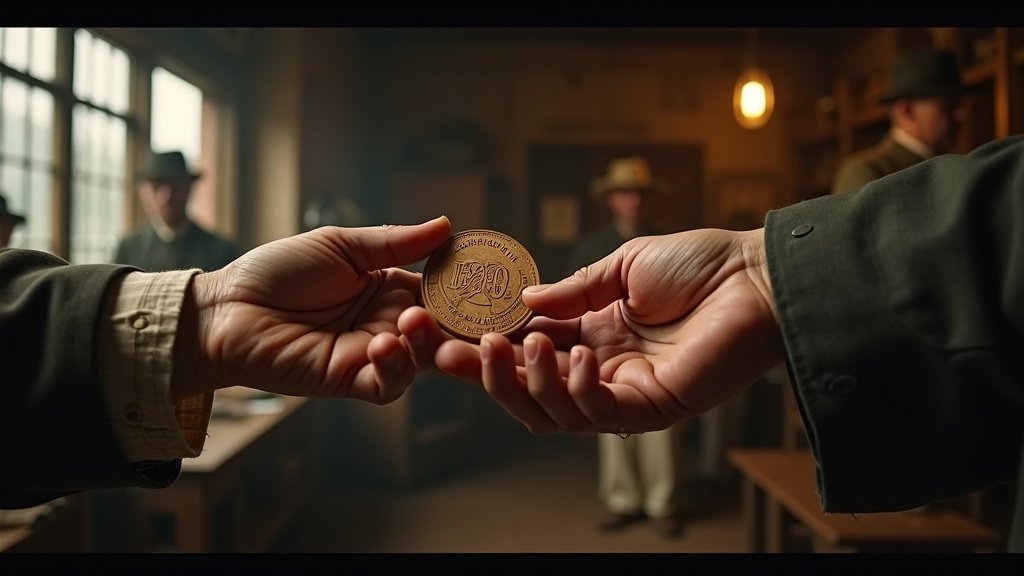In a remarkable testament to local ingenuity during a national crisis, the city of North Bend, Oregon, once issued its own currency crafted from the distinctive local myrtlewood. What began as a desperate measure during the Great Depression remains a unique part of American financial history: these wooden discs are, to this day, still considered legal tender within the city limits of North Bend. This fascinating chapter offers a compelling editorial look at community resilience and the unexpected ways towns can navigate severe economic hardship.
The Genesis of Wooden Wealth: A Depression-Era Innovation
The story of North Bend’s myrtlewood money is deeply rooted in the economic turmoil of early 1933. The Great Depression had brought the nation to its knees, with widespread unemployment, business closures, and a profound lack of confidence in the banking system. North Bend, a thriving timber and shipbuilding hub on the Coos Bay, was not spared. In early January, the city’s sole financial institution, the First National Bank, abruptly closed its doors, initially for what was expected to be a 30-day period of asset shoring. However, weeks turned into months with no word of its reopening, plunging the city into a severe cash flow crisis.
City officials faced an immediate challenge: how to pay employees, from firefighters and police officers to city managers, and maintain essential services. With the bank locked, conventional currency was unavailable. This predicament spurred Mayor Edgar McDaniel, who also served as the editor of The Coos Bay Harbor newspaper, and local businessman Irvin Ross to devise a groundbreaking solution. On March 10, 1933—59 days after the bank’s closure—North Bend announced it would print its own emergency currency. This wasn’t an entirely novel concept; across the country, various communities experimented with local scrip, using everything from paper to sheepskin and even clam shells. North Bend, however, chose a material as unique as its coastal Oregon setting: myrtlewood.
Crafting a Community’s Currency
The choice of myrtlewood (Umbellularia californica), a rare and beautiful hardwood native to the southern Oregon coast, set North Bend’s scrip apart. Known for its vibrant colors and rich grain, no two myrtlewood coins were identical, adding an inherent artistic and unique quality. The city commissioned local craftspeople to cut the wood into 1/4 inch-thick discs. These planchets, varying in diameter according to denomination, were then printed on the presses of The Coos Bay Harbor, under Mayor McDaniel’s oversight. The first series of coins was issued in denominations of 50 cents, $1, $2.50, $5, and $10. A subsequent second series would later replace the $2.50 piece with a 25-cent coin and feature more intricate designs, reflecting lessons learned in the initial production and distribution.
The new currency quickly gained acceptance. The local newspaper enthusiastically advertised its validity, listing stores, services, and individuals who would honor the myrtlewood money. City employees and contractors were paid with these wooden coins, which they, in turn, spent throughout the community, successfully re-injecting liquidity into North Bend’s stagnant economy. Each coin bore the signatures of the mayor and treasurer, guaranteeing the city’s backing and instilling public confidence in this unconventional form of tender.
From Everyday Exchange to Coveted Collectible
Initially, the myrtlewood coins were intended to be temporary, redeemable for federal currency once the First National Bank reopened. The first series was to be exchanged between June 15 and July 15, 1933, and the second by December 1, 1933. However, a surprising turn of events transpired: many residents, captivated by the coins’ distinctive beauty and historical significance, chose to keep them as souvenirs rather than redeem them. Despite repeated appeals from the city, a significant number of the wooden discs remained out of circulation, cherished as mementos of a challenging time and a community’s innovative spirit.
Recognizing the public’s attachment and the limited number of redemptions, North Bend’s city officials made a pivotal announcement: the myrtlewood money would forever remain legal tender within the city limits. This pronouncement cemented their place in local lore and numismatic history. Today, while technically usable, it’s rare to find someone paying for goods with a myrtlewood coin. Their value as collectibles has far outstripped their face value. A single $1 piece from the first issue, for example, sold for $75 in 2016, representing a 7,400 percent premium. More common pieces typically fetch between $20 and $30 on the retail market, while rarer denominations, particularly the $10 coins, can command hundreds and are often untradeable due to their extreme scarcity. A complete set of both series was reportedly auctioned for $2,600 in 2021, underscoring their enduring appeal.
A Lasting Oregon Legacy
The myrtlewood money stands as a powerful symbol of ingenuity and self-reliance. It highlights how a small Oregon town, facing an unprecedented financial collapse, leveraged its local resources and community spirit to overcome adversity. The story of North Bend’s wooden currency continues to be a point of pride and a unique news item that draws attention to the city’s rich history. As Coos History Museum historian Steve Greif observed, North Bend executed its wooden money initiative in an exceptionally beautiful and artistic way, making it a standout among Depression-era scrip. Even today, the lore surrounding these wooden discs serves as an important editorial reminder that in times of crisis, innovation and community trust can forge unexpected paths forward, literally turning trees into a lifeline for an entire town.




